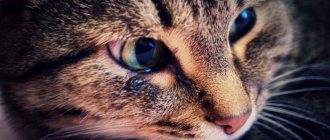Have you ever thought that the forces of nature are as powerful as they are fragile? Life does not stand still; dynamically developing humanity continually reaps the consequences of its rapid ascension to the throne of the “crown of nature.” Deforestation, agricultural development, targeted extermination of one or another animal species, poaching, global warming in the end - all this does not pass without leaving a mark on the inhabitants of flora and fauna. Life in the bosom of nature is far from easy - numerous species of animals wage a desperate struggle for survival, and the strongest always wins. One way or another, even if not directly, it is man who becomes the cause of the extinction of one or another animal species.
The topic for our conversation today will be rare representatives of the cat family, which are gradually disappearing from the face of the Earth.
Amur tiger
Despite conservation measures, the population of the Amur tiger is recovering very slowly.
It is also Siberian, it is Far Eastern, it is also Ussuri. This noble, incredible beast is the largest representative of the cat family and the only one of the tiger species who can survive in the harsh conditions of the Ussuri forests. The population of the ruler of the taiga declined rapidly from the end of the 19th century to the 30s of the last century, until it reached 20-30 individuals! The extermination of the species was facilitated not only by targeted poaching for the beautiful striped skin and other parts of the tiger carcass for further sale to Asian countries, but also by a reduction in the number of ungulates in the tiger’s habitat and active deforestation of taiga areas. As of 2015, according to the tiger census, 520-540 Siberian tigers live in the Russian Far East. The animal is listed in the Red Book and has the status of an “endangered species,” but there is still hope for the Amur tiger.
svetlana-sutyrina-amurskiy-tigr-2.jpg
Amur tiger. Photo: Svetlana Sutyrina
Interesting Facts
- The Amur tiger lives in low mountains, preferring river valleys and wide valleys between ridges, covered with forest.
- The tiger is omnivorous. He can eat both a frog and a bear. However, in the wild, Amur tigers prefer to feed on ungulates: deer, wild boar, roe deer and musk deer. For adequate nutrition, one tiger needs about 50–70 ungulates per year. At the same time, a tiger can eat up to 35 kg of meat in one go.
- A tiger can jump 5 m upward and 10 m long.
- A tiger's tail is a kind of indicator of its mood. When the tiger is calm, the base of its tail is lowered and the end is curved smoothly upward.
- The span of a tiger's whiskers roughly corresponds to the width of its body. Thanks to its whiskers, the predator is able to determine the nature of the surface, temperature, and wind direction. The animal is guided by its whiskers when moving in the dark.
Since 2010, the Russian Geographical Society has supported the Amur Tiger project. Its goal is to study the state of the Amur tiger population and develop scientific foundations for the conservation of the animal. In 2013, on the initiative of the President of the Russian Federation, Chairman of the Board of Trustees of the Russian Geographical Society, Vladimir Putin, the Society became the founder of an autonomous non-profit organization. Its activities focus on the fight against poaching, scientific analysis of the state of the Amur tiger population and ecosystems in the animal’s range, and the organization of educational and educational events.
Far Eastern leopard
The Far Eastern leopard is the rarest subspecies of the cat family on Earth. Currently on the verge of complete extinction. According to various estimates, about 80 individuals live in natural conditions. At the same time, most of the population lives in Russia in the Primorsky Territory and a smaller part lives in China. About 70% of the rare predator's habitat is protected by the Land of the Leopard National Park. In the 20th century, the species was listed in the IUCN Red Book, the Russian Red Book, the IUCN Red List and in Appendix I to the Convention on International Trade in Endangered Species of Wild Fauna and Flora (CITES).
Snow Leopard
The snow leopard blends perfectly with the surrounding nature, but this will not save it when it meets a person.
Neither does the snow leopard or the snow leopard. The “ghost” predator lives mainly in the mountainous regions of Central Asia. The secretive lifestyle, as well as the inaccessibility of the snow leopard's habitats, makes it difficult to estimate the population, but experts believe that the number of this species is continuously declining. The main reason for the extinction of the snow leopard is the illegal hunting of the animal for its magnificent skin. A big problem is the undeveloped defensive behavior of the snow leopard, which, when meeting a person, prefers to timidly freeze against the backdrop of mountain slopes instead of fleeing from an armed poacher like the plague. The lack of enemies of the snow leopard among other predators played such a cruel joke. As you understand, such encounters usually end in death for the animal.
The number of snow leopards, according to WWF, is about 4,000 individuals; only 70-90 snow leopards live in Russia.
Kinds
The Pallas' cat species includes three subspecies. They have an almost identical appearance and differ from each other only in coat color.
| Subspecies name | Peculiarities | Spreading |
| Regular (Siberian) | The color is dominated by gray and pale yellow shades | Mongolian steppes, Transbaikalia, northern China |
| Central Asian | The coat has a buffy-red hue, the longitudinal stripes in the back of the body are reddish-brown | Iran, Afghanistan, some Central Asian countries |
| Tibetan | The color is darker with a predominance of gray shades; in winter the fur becomes lighter | South Asia, Tibetan Plateau |
Caucasian jungle cat
House prefers to live near bodies of water, hiding in the thickets of cattails.
This cute fellow inhabits the Caucasus, Iran and the regions of Turkey bordering Transcaucasia. In Russia, it can be found in the Volga delta, in cattail and reed thickets. Another name for this species is swamp lynx or house. The number of Hausas has a pronounced downward trend; according to approximate data, in Russia the population barely reaches 500 individuals.
In some regions, the population of the jungle cat is close to extinction, the reason for this is the anthropogenic impact on the reed and reed lands in which the house lives (draining wetlands, burning and mowing down thickets). The bog lynx does not tolerate frost well, so particularly cold winters also contribute to a decline in the population. By the way, the House sometimes crosses with ordinary domestic cats; there is even a special breed of Chausie cats, for which a jungle cat was used.
Habitats and lifestyle
Wild Caucasian cats live in different countries. They can be found in the forests of the Krasnodar region, Chechnya, Turkey, Dagestan, North Ossetia and the Caucasus mountains. Coniferous and broad-leaved forests, rocky slopes and mountain peaks are chosen for living. In rare cases, cats of this breed take root in human buildings.
Smart predators settle in rock crevices, hollows, burrows and other hidden places. Each Caucasian cat has its own area, which is personally guarded and periodically marked. This area can reach 3 km.
The festivities season begins in February-March. Cats become pregnant and bear kittens for 65-70 days. One litter produces no more than 5 individuals.
Up to 4 months, kittens live with their mother, who provides them with food and the necessary care. The growing cubs are taken on hunts and taught the necessary skills to survive in the environment.
Cheetah
Female cheetah with cubs
The fastest predator of the cat family is the cheetah. Distributed throughout Africa, as well as in the Middle East. The cheetah is significantly different from all other big cats, since, like canines, it is able to pursue prey over fairly long distances (cats, as a rule, do not run after prey, they prefer to kill it by pouncing from cover in one powerful, deadly leap), and also has non-retractable claws.
As of 2007, there are only 4,500 adult cheetahs in Africa, and the Asiatic cheetah subspecies found in Iran numbers no more than 60 individuals. Factors such as a decrease in the number of ungulates and persecution by humans have led to the vulnerability of the species. Cheetahs reproduce very poorly in captivity due to the peculiarities of social behavior; moreover, all existing cheetahs are close relatives of each other, and inbreeding always leads to genetic degeneration of the species. Perhaps due to inbreeding, more than half of all cheetah cubs do not survive one year.
Interesting facts about the manul
- All attempts to tame a wild cat ended in failure. Even kittens that have contact with humans from the first days of life begin to show the instincts of a wild animal at the age of 3-4 months. Pallas cat not only cannot be domesticated, but also does not tolerate life in captivity well. Animals brought to zoos often suffer from various infectious diseases, especially toxoplasmosis. This is due to the lack of an immune response to pathogens. In their natural environment, Pallas' cats practically do not encounter infectious pathogens, which did not allow the animal to develop reliable defense mechanisms. A high mortality rate is also observed among kittens born in captivity.
- The fur of the Pallas's cat is second only to the Arctic fox, chinchilla and sea otter in thickness: up to 9 thousand hairs grow on every square centimeter of the predator's skin. To avoid damaging the animal's fur, hunters used traps.
- Manul is not the only wild cat. There are several other species of small cats in the world that have never been domesticated. These include the jungle cat, which lives in the southern regions of Asia, the forest cat, which can be found in the Middle East and Africa, the Amur cat, common in the Far East, as well as the steppe cat, which prefers to settle in the desert regions of Asia and Africa.
- Employees of several Russian nature reserves are trying to preserve the endangered species and increase the population size: Sayano-Shushensky, Daursky, Altai State Biosphere Reserve. Observing Pallas' cats in protected areas also allows us to study in more detail the animal's lifestyle and behavioral characteristics.
Fishing cat
The fishing cat is an excellent swimmer and even dives in search of fish.
An inhabitant of the tropical forests of Southeast Asia, the fishing cat is an excellent swimmer and is not at all afraid of water. There are membranes on its paws that prevent the claws from being fully retracted, but help in fishing. In 2008, the fishing cat joined the list of endangered species. This is all due to the fact that the wetlands chosen by her are drained and developed by humans. The population of fishing cats numbers about 10,000 adults.
Reptiles
Approximately 70 species of animals represent the class of reptiles in the country. About 20 species are listed in the KKRF. They are common on the coast of water bodies and in forest areas.
Far Eastern skink
Far Eastern skink
The Far Eastern skink is a genus of lizards. Lizards live on Kunashir Island - near forests and on the river coast. The number is several thousand individuals. Predators such as minks and economic activities pose a danger to lizards.
Common copperhead
A representative of the colubrid family in Russia, it is distributed in the southern part of European territory. Copperheads swim well, but they try to avoid dampness, preferring dry meadows and clearings. The main diet consists of lizards.
Common copperhead
The danger for them comes from birds of prey, hedgehogs, rats, etc. Copperheads are also often mistaken for poisonous snakes. The main reason for the population decline is the use of pesticides in agriculture.
Gyurza
The viper is the largest representative of the genus of poisonous vipers. The most common in the South Caucasus (Transcaucasian viper). The main diet consists of rodents. It is considered a species whose numbers are declining. Currently there are about 1000 individuals. This happens mainly due to human activity.
Interesting: Endemic: What is it, description, examples, photos and videos
Gyurza
Interesting fact : the venom of the viper is unique and very dangerous. In toxicity it is second only to cobra venom. Widely used in medicine and pharmacology.
Kalimantan cat
A Kalimantan cat living in the Pulong Tau Nature Reserve.
Malaysia A little-studied species of wild cats lives on the island of Borneo (Kalimantan). There is no reliable data on the way of life, as well as the number of Kalimantan cats, since the animal behaves extremely carefully and the likelihood of meeting it in nature is extremely low, especially considering the active deforestation of the Kalimantan forests. A live specimen can fetch $10,000. The estimated population ranges from 50 to 2,500 mature individuals.
Reproduction
Sexual maturity in males and females occurs at the age of 10-11 months. The rutting period usually occurs at the end of February and beginning of March. Clashes may arise between males for the right to cover the female. After the mating season is over, the animals return to their territories. Feeding and raising the cubs is carried out exclusively by the female.
During pregnancy, which lasts 7-8 weeks, the cat prepares a place for future offspring. She brings from 2 to 6 kittens at a time. Until 10-12 days, babies remain blind and are completely dependent on their mother. The female feeds the cubs with milk for 3 months. Then the older kittens try to hunt on their own, remaining with their mother for several more months. Before the onset of puberty, young animals leave the female and look for a free area for hunting.
OCELOT
Sumatran cat
The flat-headed cat is very cautious and is predominantly nocturnal.
Another wild cat from southeast Asia is the flat-headed or Sumatran cat. It was considered extinct in the mid-1980s, but was rediscovered in Malaysia in the 1990s. This cat is very tiny (1.8-2.7 kg) and prefers to settle near the water, where you can splash around happily and feast on fish, frogs, and other tasty aquatic inhabitants. The flat-headed cat is active at night and is usually not visible to people, so the species has been little studied. There is information that the last meeting of a person with this cat was in 2005. There is no data on the number of livestock, but the Sumatran cat is listed in the International Red Book as an endangered species due to pollution of water bodies, destruction of habitats and depletion of fish resources.
Fish
As a result of intensive fishing, fish numbers have decreased significantly since the second half of the 20th century. Additional negative factors include an increase in the number of ships, pollution, and the extraction of building materials.
Atlantic sturgeon
The largest species in the sturgeon family. Found in the waters of the Black and Baltic Seas. The basis of the diet is smaller species of fish. Sturgeon was considered rare back in the 20th century, and is currently on the verge of extinction due to intensive fishing. Isolated cases of catching are known. It is impossible to reproduce the species artificially.
Atlantic sturgeon
Beluga
Previously, beluga was considered a valuable commercial fish, but now the species is classified as endangered. Fishing has been banned in the country since 2000. Active fishing, hydraulic construction, and poor reproduction of the species are the main factors in reducing the population size.
Beluga
Belugas are predators and are considered the largest representatives of freshwater fish.
Interesting fact : the largest beluga weighed 1224 kg or 1.2 tons. At the same time, the weight of the torso was 667 kg, the head – 288 kg, and the calves – 146.5 kg.
Sterlet
Sturgeon fish, sterlet, is found in rivers such as the Kama, Dnieper, Kuban, Ural and Don. It feeds on fish eggs and invertebrates living on the bottom. According to its conservation status, sterlet is a vulnerable species.
Sterlet
Population numbers are declining for several reasons: water pollution, poaching, and shallowing of water bodies. In addition, reservoirs and hydroelectric power stations are built on rivers, which interfere with water purification and also prevent fish from getting from the sea to the river, where they tend to spawn.
Brown trout
Trout is a fish of the salmon family, which is represented by several subspecies. In Russia, depending on the species, it is found in the waters of the Baltic Sea, lakes of Karelia, and in rivers in the Leningrad, Tver, Novgorod and other regions.
Brown trout
Currently, the number of brown trout is rapidly declining, and in some reservoirs the fish have completely disappeared. The main reasons are water pollution, construction of hydroelectric power stations, and illegal fishing.
Chinese grouper
Perch is found in the Ussuri and Amur rivers, in the northwestern part of Sakhalin, in Lake Khanka. It feeds on smaller fish and insufficient food is included in the list of main factors in population decline. It is also subject to mass fishing and suffers from environmental pollution.
Chinese grouper
Andean cat
The Andean cat prefers to live at altitudes of up to 5000 m above sea level.
The rarest cat species in South America. The habitat, as the name suggests, is the Andes. The first video images of this cat appeared only in the early 2000s. The species has been little studied - the Andean cat is difficult to observe, since it prefers to hide in low bushes and grass. There is no information on the number, but scientists suggest that the population of the Andean cat is extremely small due to the fact that the population of small rodents living in the Andes has also fallen significantly over the past few decades.
Lifestyle and nutrition
Forest cats have adapted to life in the wild and obtain food by hunting during the twilight period or at night. Excellent hearing and vision help in hunting. Prey includes hares, rabbits, birds, small rodents, muskrats and fish. Birds that nest on the ground are a favorite treat for cats. Great luck if you come across weakened deer and roe deer cubs.
A forest cat can eat up to 1 kilogram of food at a time. Predators drink little; they can even quench their thirst with sea water. In winter they hunt daily, feeding on small animals and birds. During the day, cats lie down in their den.
The home is an abandoned hole, a hollow, a crevice in the mountains. During the harsh seasons, the European wild forest cat, due to the thick snow cover, settles closer to human habitation. Here they become unwanted guests in poultry houses. Along with damage to the households of rural residents, they bring great help in the fight against harmful rodents.
Iberian lynx
The Spanish lynx is the rarest and smallest species of lynx.
The rarest species of lynx and one of the rarest species of mammals. It lives exclusively in the mountainous areas of southwestern Spain, although it was previously distributed throughout Spain and Portugal. The population of the Iberian (or Sardinian, Spanish) lynx in 2005 was only about 100 adults. The Spanish lynx is still persecuted by humans despite the fact that hunting it has been prohibited since the 70s.
Clouded leopard
The clouded leopard is one of the ancient species of cats.
The beautiful spotted-marbled coat of the clouded leopard, which lives in the tropical forests of southeast Asia, is still a valuable prey for poachers. Deforestation also played an important role in reducing the species' population. As of 2008, the clouded leopard population numbered 10,000 adults and is considered endangered. A subspecies of the clouded leopard, the Taiwan leopard, was already declared extinct in 2013.
Bornean clouded leopard
The Bornean leopard is active mainly at night.
Despite its similar name to the previous leopard, the Bornean or Kalimantan leopard is not a subspecies of it. The Bornean leopard lives in the rain and mangrove forests of Borneo and Sumatra. There is no reliable data on its abundance, but the species is classified as vulnerable due to degradation and transformation of wooded areas, which are the habitat for this species, into rubber plantations.
Insects
Insects form the most important link in the food chain and represent the most numerous group of animals. Several tens of thousands of their varieties are common in Russia. About 100 species are listed in the KKRF.
Stag beetle
The largest beetle within Europe. In our country, it is often found on European territory (including in the Belgorod and Voronezh regions). Beetles feed on bark, wood, nectar, dew, etc. Recently, population declines have been observed everywhere and the reason for this is human forestry activities.
Stag beetle
Interesting fact : the stag beetle is interesting for collectors who collect individuals in immoderate quantities.
Smooth bronze
The smooth bronzer
The smooth bronzer lives in the central part of the country. Insects prefer old forests with large trees. They feed on tree sap and are sometimes found on fruits and flowers. Despite the lack of accurate data, scientists believe that the number of beetles is declining due to the destruction of forests and old trees.
Black-footed cat
The black-footed cat is the smallest representative of wild cats in Africa.
A resident of South Africa, the black-footed cat (other names - small spotted cat, informal ant tiger) is one of the smallest wild cats. The weight of an adult male is from 1.5 to 2.4 kg. Black-footed cats often occupy abandoned burrows of other animals or settle in termite mounds. Although the cat is not of interest to hunters, it is nevertheless considered a threatened species, since it often dies from poisons and traps set for jackals, and besides, the places chosen by it are actively developed by people and converted into pastures for livestock. The black-footed cat interbreeds with domestic cats, which also contributes to the degradation of the species.
Appearance
What does a manul look like? In size, it differs little from domestic cats: it reaches a height of 65 cm, a length with a tail of 95 cm. The average weight is 3-5 kg. This cat has a rather dense body, short legs and incredibly thick fur, which visually makes the animal larger. The coat is fawn, grayish with white tips; there are thin transverse dark stripes on the tail and back; Vertical black stripes extend from the corners of the eyes to the sides. There are pronounced dark spots on the forehead. The tail is very fluffy and thick with a rounded end.
A small, slightly flat head with small, widely spaced, rounded ears. The eyes are yellow; the pupils, when reacting to light, remain round and do not become vertical like those of domestic cats.
The subspecies have slightly different colors:
- The typical grayish color of Otocolobus manul manul (most commonly found in the wild).
- Otocolobus manul ferruginea (common in Central Asia) has ocher fur with reddish stripes.
- Grayish color, acquiring a silvery tint in winter in Otocolobus manul nigripecta (found in Tibet, Kashmir and Nepal).
Chinese cat
In Chinese, the Gobi cat's name is "huang mo mao", which means "yellow-furred cat."
Also called the Gobi cat, it is a Chinese endemic and is found primarily in the mountainous and steppe regions of northwestern China. Outwardly it resembles a jungle cat. The Chinese cat is a rare species and belongs to the vulnerable species. According to approximate data, the number of Chinese cats is less than 10,000 mature individuals. The Chinese cat is pursued by humans because its skin is of interest to artisans. There is evidence that the campaign to exterminate rodents, which are the main food for this feline, carried out in the late 50s played a big role in reducing the number of Gobi cats.
Nutrition
The wild cat is helped in hunting by its camouflage color, thanks to which it blends into the landscape. Its main diet is rodents, but it can also catch a gopher, a hare or a bird. In times of hunger, it does not disdain Orthoptera and other insects.
Prey, as a rule, lies in wait near burrows or under stones. The wild manul is not able to run fast; in case of danger, it hides from enemies in rocks and between stones.
Chilean cat
Kodkod is an excellent climber and excellent tree climber.
Another predatory baby comes from South America. Its other name is kodkod. The weight of an adult cat is a maximum of 2.7 kg. The species is included in the International Red Book as vulnerable; the population of the species is about 10,000 adult animals. The species is threatened by both poachers and habitat loss (deforestation).
Oncilla
Oncillas living in Brazil, despite their modest size, catch even small primates.
The name of this cat means “little jaguar.” Oncilla lives in mountainous and subtropical cloud forests of South America. In the wild, the species is practically unstudied. The oncilla's exquisite fur makes this small cat a desirable target for poachers—an estimated 84,000 oncilla skins were seized in the early 1980s!
Hunting for oncilla is prohibited, but its numbers are small (about 50,000 adult cats) and are constantly declining due to logging and the conversion of forest areas to coffee plantations.
Character and habits
The forest cat is very timid, distrustful and unfriendly. Leads a hermit's lifestyle. They hunt small forest rodents, birds, hares, and rabbits. The predator can stalk its prey for hours and, thanks to its lightning-fast movements, powerful claws and sharp fangs, can grab its prey in a jump. Sometimes they wait for prey near the hole.
Forest cats have adapted to live in the wild in difficult conditions in remote, inaccessible places. They prefer to live alone, marking their territory with an area of about 2–3 kilometers. There is a struggle for the development of the territory with other representatives of wildlife.
Iriomotean cat
The Iriomote Island cat is a subspecies of the Bengal cat.
An extremely rare species that is endemic to the subtropical Iriomote Island, part of Okinawa Prefecture, Japan. This cat originally had a limited range and an extremely modest population. At the moment, the number of Iriomotey cat is no more than 100 adult individuals.
Some locals consider its meat a delicacy, which greatly harms the species. Crossbreeding with wild cats of other species also contributes to the decline of the Iriomotean cat. The species is on the verge of extinction, therefore it is protected and listed in the International Red Book.
Description of the animal
The weight of the female ranges from 3 to 6 kg, the male can reach 6.8 kg. There were individuals that gained weight of 11 kg. The body reaches a length of 50 cm. The head is round, the eyes are expressive. The eyes have a third membrane that protects the organ of vision from damage.
The voice is hoarse, makes sounds characteristic of cats, but with a much greater emotional coloring. It not only meows, but also growls, hisses, snorts, and howls.
The tracks of a wild animal are the same as those of a domestic animal. The only difference is the larger size. It climbs trees well and has sharp retractable claws on its paws. The hind legs have four toes, the front legs have five.
| Scientific classification | |
| Kingdom | Animals |
| Type | Chordata |
| Class | Mammals |
| Squad | Predatory |
| Family | Felines |
| Genus | Cats |
| View | forest cat |
| Subspecies | Caucasian forest cat |
| Latin name | Felis silvestris caucasica |
In the mouth there are sharp fangs, with the help of which the animal holds and kills prey, and molars, intended for chewing meat. The tongue is hard, allows you to lick meat and care for the coat.
What does it look like
The Caucasian cat looks like an ordinary domestic mongrel cat, except that it is larger in size. The coloring is gray, with a small reddish mark. There is a black stripe along the ridge. There are also short transverse stripes on the sides and on the head to the back of the head.
The belly, throat and groin area are covered with light yellow fur. There are sometimes dark spots on the stomach. The tail is striped, with dark rings on a gray background. There can be from three to eight. In summer the color is brighter than in winter. During the cold season, the coat becomes thicker.
This coloring allows the animal to camouflage well while hunting. The cat goes hunting at night, and often sits in ambush.
Character and lifestyle
Settles in hollows, crevices, heron nests, abandoned burrows of badgers or foxes. May live in abandoned houses or near housing. It can also live in thickets of bushes or reeds. Prefers to lead a solitary lifestyle. Each individual has its own controlled territory. Usually it does not exceed three kilometers.
The peculiarity of the animal is that to mark the territory, the cat not only sprays urine, but also uses the secretion of special glands that are located around the mouth, on the forehead and near the base of the tail. The cat rubs against different surfaces and leaves an individual smell.
This is a solitary animal, but in places with high numbers, a certain hierarchy is formed between individuals that are often in contact. To protect its own territory, it can be belligerent.
The animal prefers to sit in ambush for a long time and wait for the right moment to attack. A sharp jump from an ambush can reach three meters. Sometimes it catches up with prey, but such cases are very rare.
A wild forest cat can swim, but will not get into the water without a special reason.
What does it eat?
The basis of the diet is small rodents, lizards and birds. It can also hunt pheasants or small-sized artiodactyls (young individuals). Very rarely catches fish or crayfish. Can also eat roots or some herbs.
During periods of food shortage, it can hunt hares or domestic animals. It can also destroy nests for eggs or chicks. Sometimes it feeds on young cereals, fresh carrion or fruits.
The wild cat is a highly successful hunter and poses a danger to river rats, waterfowl, squirrels, stoats, young large animals, as well as injured goats and other herbivores. Often attacks domestic animals and gets into fights with dogs.
When hunting large prey, it tries to gnaw through the carotid artery. In hunted large animals, the liver, heart, and lungs are primarily eaten.
Where does it live?
The animal is found in the forests of Central Asia, Western and Eastern Europe. Prefers deciduous and fir forests. The Caucasian forest cat on the territory of the Russian Federation is found only in the Krasnodar Territory. The number of this species is so small that records are kept of each individual.
This species is considered the largest among forest cats. In the Red Book, this species is number three, as one of the rarest species that are on the verge of extinction. Found in the lower reaches of the Kuban and Terek.
Reproduction
The mating season lasts from February to March. The female secretes special substances that attract males. A cat bears kittens for approximately 70 days.
There are three to five babies in the litter, which feed on mother's milk for four months. Only the female is responsible for raising the cubs, although cases have been recorded when the male brought prey to the den of the female with the cubs.
If the first litter of the season dies, the female is able to become pregnant again. Sexual maturity occurs at 9-10 months (females) or three years (males). Life expectancy in the zoo is 30 years, in the wild - 15.
Natural enemies
Lynxes, jackals, jungle cats, martens and foxes can pose a danger to the animal. In case of a threat to life, the animal develops high speed or climbs to the tops of trees.
Wintering
During snowy and cold winters, annual seasonal migrations occur to places more suitable for habitation. Deep snow prevents rapid movement, which is why the wild cat is forced to change its place of residence. If conditions are favorable, the animal spends the winter where it lives.
Amur forest cat
The Amur cat lives in most reserves of the Primorsky Territory
. Another name is the Far Eastern cat. It is a subspecies of the Bengal cat. Habitat: Far East, coast of the Sea of Japan. The species is considered rare and is listed in the Red Book of the Russian Federation. The population of the Primorsky Territory numbers about 2-2.5 thousand adult individuals, and the population is currently growing. The species is threatened by weather conditions, habitat degradation, and interbreeding with domestic cats. The population of the Far Eastern cat on the Japanese island of Tsushima (where the species is called the Tsushima leopard cat) numbers only about 100 individuals and is under state protection.
Rusty cat
The smallest cat in Asia spends most of its time on the ground, although it climbs trees very well.
The smallest representative of Asian wild cats (average weight of an adult animal is 1.6 kg). It lives only in India and Sri Lanka. The population, which is constantly declining, is about 10,000 adult cats. The species is threatened by changes in its natural habitat (deforestation). The rusty cat is often kept as a pet due to its playful, good-natured nature.
Far Eastern leopard
The Amur leopard reproduces extremely poorly in captivity.
The rarest subspecies of leopard is on the verge of extinction and is included in almost all protection documents. In the Primorsky Territory National Park “Land of the Leopard” there are only 87 individuals (as of 2017), about 12 more adult animals are in China. Huge damage to the Far Eastern or Amur leopard was caused by poachers. The illegal shooting of animals was caused by the widespread demand for skins and other parts of carcasses, which are used in oriental medicine, as well as unemployment and poverty of the population of the Primorsky Territory. The species is threatened by a reduction in the number of ungulates, habitat degradation and inbreeding, which causes genetic depletion of the species (due to a small population).
Sumatran tiger
The Sumatran tiger is very ferocious and can attack people.
It is endemic to the island of Sumatra, located in the western part of the Malay Archipelago. The Sumatran tiger is the smallest representative of the tiger species, but the most aggressive. The species is small in number and is endangered due to illegal hunting and habitat destruction. The cost of a Sumatran tiger carcass on the black market is $20,000. Sumatran tiger attacks on humans are not uncommon: at least 8 people have been killed by them since 2002. Listed in the International Red Book and the CITES Convention.
Source
How to hunt
Pallas' cats are quite slow and clumsy, so during hunting they prefer a wait-and-see tactic. They set up ambushes in trees, among grass or stones and attack the victim with one quick and accurate throw.
Typically, wild cats stalk prey near burrows or trails leading to feeding areas. Pallas' cats can stick their paws into shallow holes and reach small animals hiding there.
What does it eat?
The wild cat hunts small rodents (marmots, hamsters, voles, jerboas), pikas, and squirrels. The animal's diet includes several species of birds, mainly nesting on the ground. Pallas' cats can attack hares.
In the absence of the usual food supply, cats eat large insects: crickets, grasshoppers, locusts.
Before the onset of cold weather, the animal consumes more food, and in winter it may eat less often than usual.











